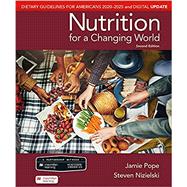Jamie Pope, M.S., R.D., has been with Vanderbilt University since 1986, working in the areas of obesity research, weight management, health promotion, heart disease prevention. Since 2000, she has been Instructor of Nutrition in the School of Nursing. In addition to her current work on Nutrition for a Changing World, Jamie co-authored several best-selling books, including The T-Factor Fat Gram Counter, and is author of The Last Five Pounds: A Liberating Guide to Living Thin. She has authored or contributed to numerous other scientific and popular press publications. Jamie’s popular classes bring together undergraduate students from a wide range of majors to learn about nutrition science and its application to their personal and professional lives. Jamie is a long-time member of the Academy of Nutrition and Dietetics and served as media representative for the Tennessee Dietetic Association, during which time she was named as Outstanding Dietitian of the Year for the Nashville District Dietetic Association. Jamie served for over a decade as nutrition consultant for Smart Balance, Inc.
Steven Nizielski, M.S., Ph.D., earned his Bachelor of Science degree from the University of Minnesota in Wildlife Biology and assisted in research projects involving Siberian tigers and grey wolves before entering graduate school. He earned his masters and doctorate degrees at the University of Minnesota in nutrition with an emphasis in biochemistry. He is currently an associate professor in the Department of Biomedical Sciences at Grand Valley State University in Allendale, Michigan, where he teaches introductory nutrition, clinical nutrition, public health, advanced metabolism, and sports nutrition courses. His current research seeks to identify cellular adaptations in adipose tissue in response to aging and endurance training. Steve is a fellow of The Obesity Society, and a member of the American Society for Nutrition (ASN) and of the American Physiological Society (APS). He is an avid competitive cyclist, and also enjoys cross-country skiing, hiking, and camping.









